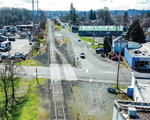

Amid concerns of increased noise pollution and traffic, Battle Ground’s City Council unanimously adopted a resolution opposing the proposed expansion of the Portland Vancouver Junction Railroad (PVJR) in a March 18 meeting.
PVJR’s Freight Rail Dependent Use plan in Chelatchie would allow the shipment of aggregate through rail in Clark County. This expansion would reactivate the currently unused rail, which crosses through Main Street in Battle Ground, for rail shipment. The rail also cuts through Rasmussen Boulevard, west of Battle Ground Village.
In their resolution, City Council members asserted increased train traffic through the city would be adjacent to several residential homes, decreasing the property value and quality of life for residents. The council argued the railroad’s reactivation would create safety hazards. Rail traffic through the city would delay the response of emergency vehicles, and the rail’s proximity to the skate park frequented by youth poses a risk, the council said.
“Many railroad crossings located in Battle Ground are at-grade and not properly signalized. The reactivation of the rail line would require capital improvements costing a substantial amount of taxpayer funds, resources that the council believes would be better used elsewhere,” the City Council wrote in a news release.
Council members have shown interest in a tourism-based use of the rail, opposing aggregate shipments through the city’s currently unused railing.
“We [the City Council] see potential in developing the railroad for tourism-related uses, celebrating the history of the railroad and the beauty of our region,” Battle Ground Mayor Troy McCoy said in a news release. “The proposed reactivation of the Chelatchie Prairie Railroad for industrial use would have long-term adverse effects on our city’s economic health and livability. It is for these reasons the Battle Ground City Council is compelled to speak out against this project, on behalf of our community.”
The City Council also opposed the proposed overlay of 400 acres of land in Brush Prairie to heavy-industrial usage. The land is located west of state Route 503, south of Battle Ground city limits. Some Brush Prairie residents, including Josie Calderon, spoke before the City Council in opposition to the overlay.
“I am ground zero to this. I [recently] purchased my home in October, not once was told about this, had no idea” she said.
Calderon said that the new railing would decrease the property value of her and her neighbor’s homes and fears that the rail’s use would increase noise pollution for residents. She criticized the county and railroad operator for not communicating with residents living blocks away from the overlay.
“…I’m not happy that they did not consult with any of our neighbors in regards to what they want to do,” she said.
PVJR President Eric Temple sent McCoy a letter following a March 4 meeting in which the City Council agreed to adopt a resolution the following meeting. Regarding traffic concerns, Temple argued that shipping aggregate by rail would decrease the amount of trucks shipping aggregate on roads and that businesses in the new Brush Prairie overlay would be an economic boon for Battle Ground.
“Increased economic activity within Battle Ground will naturally generate additional sales tax revenue, bolstering city coffers for investments in essential services and infrastructure that benefit all residents,” Temple wrote in a letter to McCoy.
As the overlay is located outside of city limits, Battle Ground would not receive tax revenue from future spending within the overlay. Temple wrote that the Brush Prairie overlay was a project independent of the aggregate- by-rail project and would not further increase rail traffic brought by the rail expansion.
“We advocate for the smaller 400-acre size, promoting a more responsible use of land,” Temple wrote to McCoy. “Additionally, we believe the heavier industrial zoning for this park is unnecessary and potentially detrimental to the concerns many have shared.”
In a second letter sent March 18, Temple wrote that PVRJ would commit to having trains operate through Battle Ground after peak hours to reduce traffic through Main Street. McCoy told The Reflector that he thanked Temple for communicating despite their disagreements and found it interesting that PVJR’s president was against the heavy-industrial zoning within Brush Prairie.
The resolution opposing PVJR’s rail expansion was sent to members of Clark County Council, local legislators, the Washington State Department of Commerce and Gov. Jay Inslee. Future decisions regarding the rail’s usage will be made by the county.